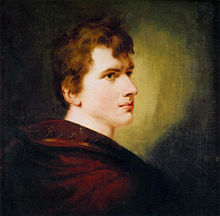Mrs. of Saverne
Frau von Saverne is a story by Achim von Arnim that appeared in the magazine “ Der Gesellschafter or Blätter für Geist und Herz ” in Berlin at the end of October 1817 .
content
Around 1784, the rich widow Frau von Saverne from Avignon treats herself to an educational trip to see her revered king in Paris. Your confessor from a convent in Avignon is against the expensive undertaking. In vain he had recommended that the woman associate with his brother, a young papal captain, for amusement. Madame de Saverne wants to see the king at least once. So she quartered in Paris and - much to the annoyance of her maid - gives away money to the poor and the disabled. Frau von Saverne never saw the king. Because when the ruler finally wants to show himself and she is pushed further by a crowd, she is held back by a stranger whom she calls the Nutcracker because of his "sharp face with a monstrous mouth". Frau von Saverne recalls. The creep had already followed her across town. Of course, the generous woman has become known in no time among the poor and needy in Paris. As soon as she enters the street, people gather around her, hoping for a gift of money through the presentation of stories of suffering, some of which are made up. During one of these performances, she is arrested by the Nutcracker, who turns out to be a ruthless law enforcement officer in a Parisian court. He has Frau von Saverne declared insane. She is locked in a madhouse and cured there. In one of the tortures, the woman is put on a terrible spinning wheel. The torture does not want to end.
The nutcracker finally knows a way out. Frau von Saverne, widow of a papal official, daughter of the silk manufacturer Lonny in Lyon , would have to marry the nutcracker. The woman appears to respond to the request. Full of expectation, the nutcracker travels to Avignon with his bride to be married. The confessor asks the couple under the pretext of the wedding to his monastery church. There the nutcracker jumps into the confessional and confesses his sin; depicts the kidnapping of Frau von Saverne in the Paris madhouse as “well-made tenderness”. For this, the bridegroom should pray six Our Fathers in a dark place before the wedding . Said and done. The nutcracker realizes too late - the place in which he was locked up is the treadmill of the monastery oil mill. The nutcracker has to kick until he - completely exhausted - wants to let go of Frau von Saverne forever and ever. Relieved, the woman decides in favor of the young papal captain, the brother of the confessor.
reception
- The story is "an entertaining, lively, colorful representation".
- Gutzkow wrote in 1835 that after all you no longer know where you are and you ask yourself who is actually being foolish - Frau von Saverne, her enemies or the reader? The author always keeps his distance.
- Arnim criticizes Hardenberg's Prussia : the turning wheel was common in Berlin; not in France. In addition, Moering sees a parallel between Louis XVI. and Friedrich Wilhelm III .
literature
- Renate Moering (Ed.): Achim von Arnim. All the stories 1802–1817. Vol. 3 in: Roswitha Burwick (Hrsg.), Jürgen Knaack (Hrsg.), Paul Michael Lützeler (Hrsg.), Renate Moering (Hrsg.), Ulfert Ricklefs (Hrsg.), Hermann F. Weiss (Hrsg.): Achim von Arnim. Works in six volumes. 1398 pages. Deutscher Klassiker Verlag Frankfurt am Main 1990 (1st edition), ISBN 3-618-60030-5
Quoted text edition
- Achim von Arnim: wife of Saverne . Pp. 241-253 in Karl-Heinz Hahn (Ed.): Brentano. Arnim: Works in one volume. 364 pages. Library of German classics. Issued by the NFG . Aufbau-Verlag Berlin and Weimar 1973 (1st edition)
Web links
- The text at Gutenberg-DE
